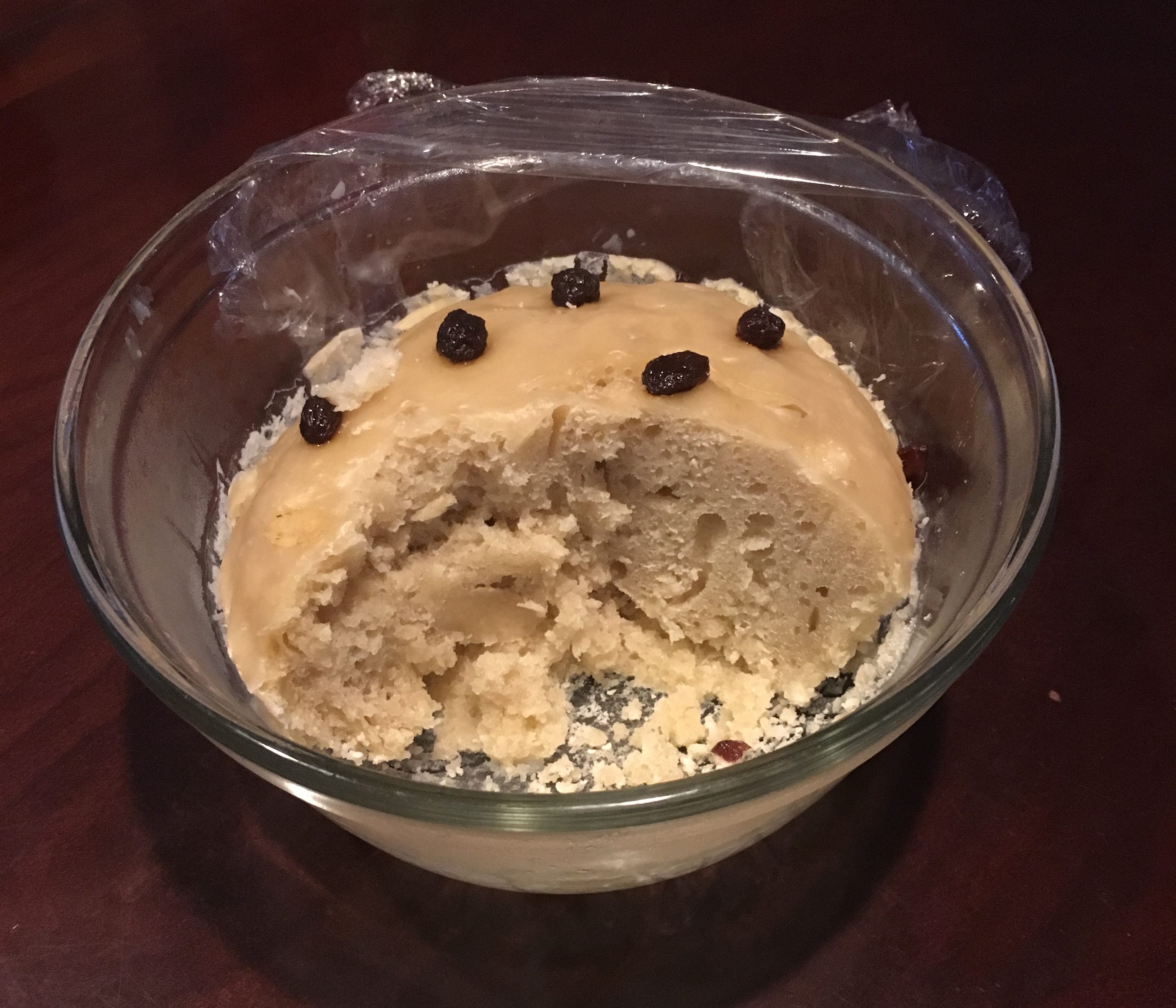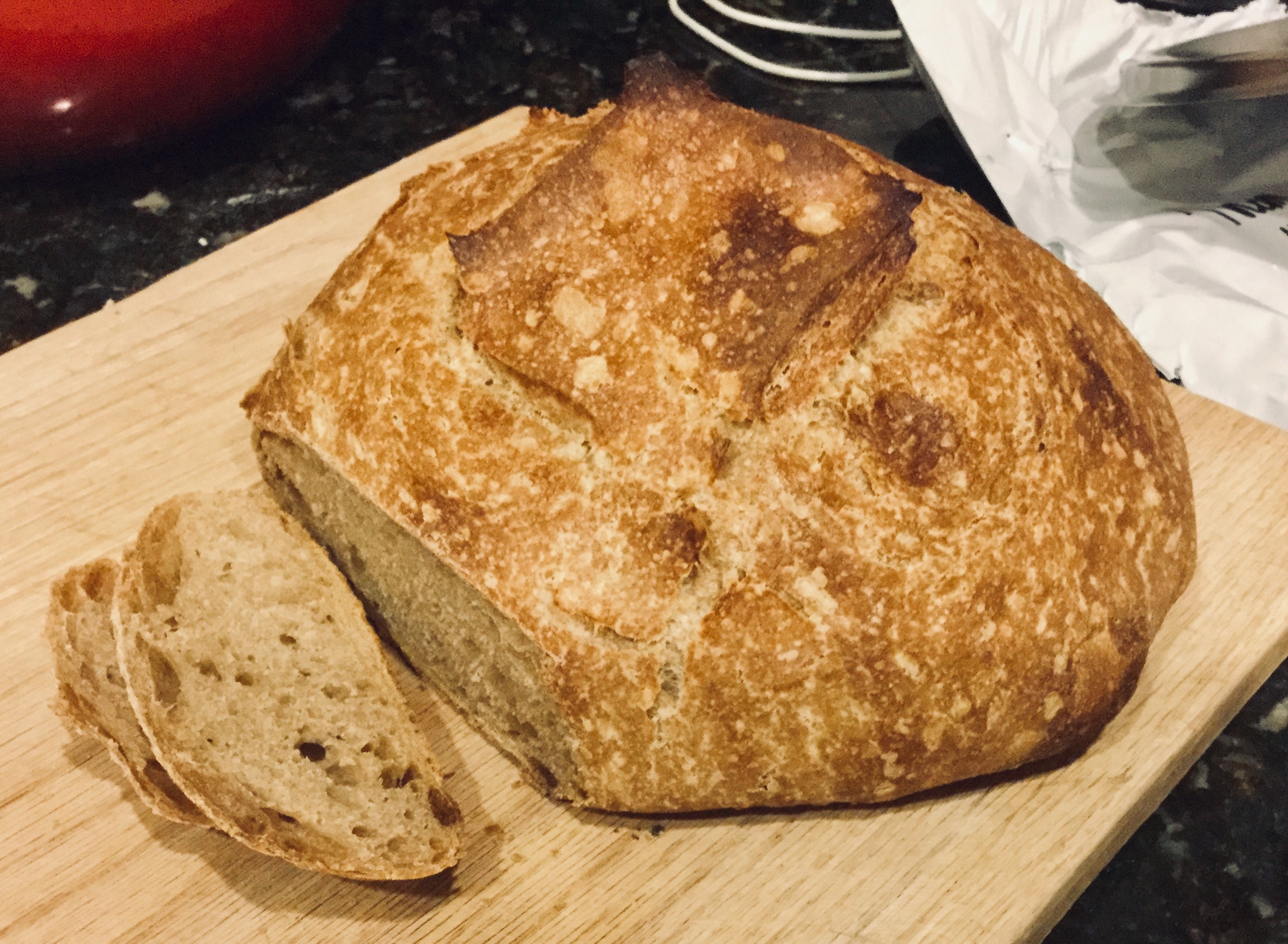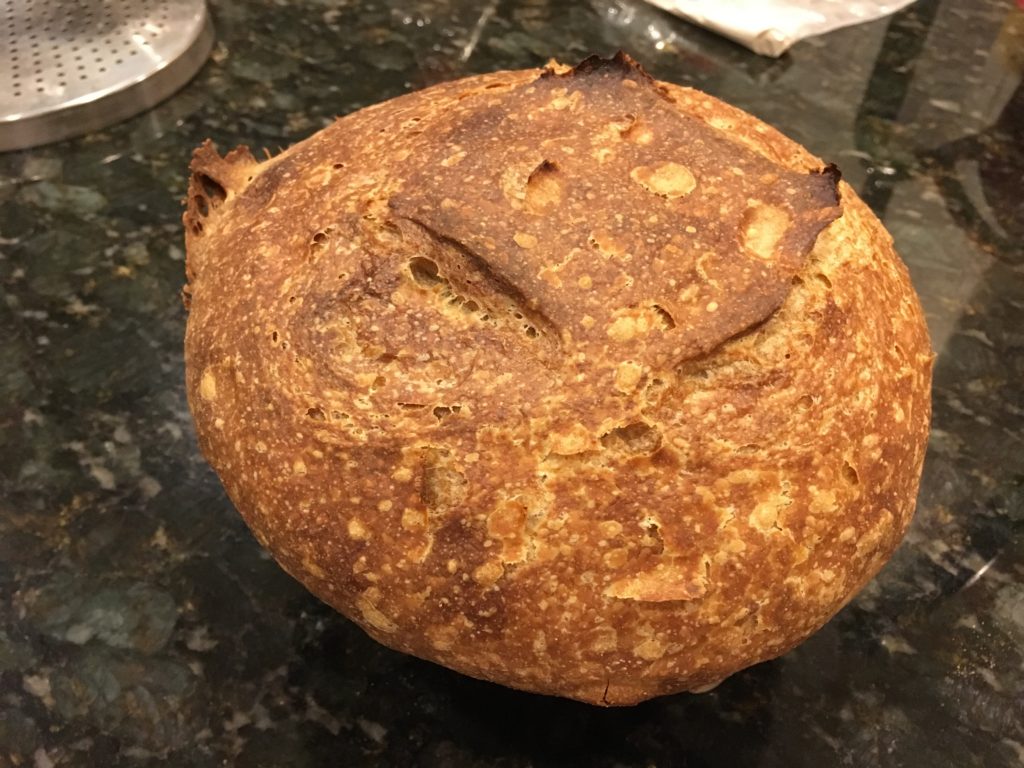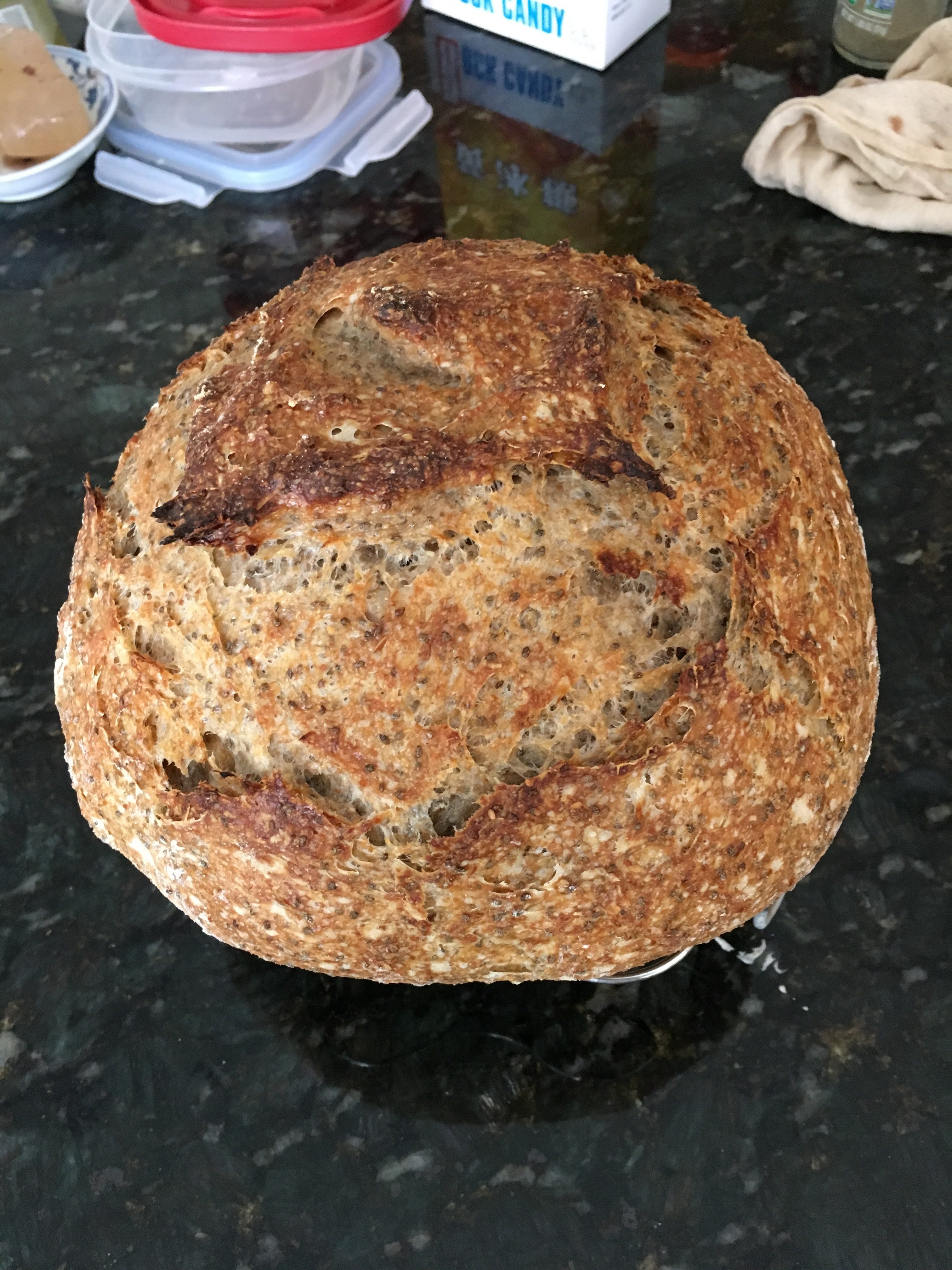
I am publishing this way after the fact, but I believe this is one of our early forays into steamed bread.
GRIZZLY PEAR

I am publishing this way after the fact, but I believe this is one of our early forays into steamed bread.
I’ve been enjoying the products of the food scientists at the local fast food chains and it’s become clear it’s time to change things up.
Our office has a large break room with a good sized kitchen sink, so I woke up this morning and realized that if I brought some balsamic vinegar, olive oil, the salad spinner, some greens, and nuts, I’d be doing pretty darn good. There is also a range, so I could also bring eggs if I’m feeling particularly fancy.
I suspect I’ve been trapped in a mindset created way back in Houston when we didn’t have a car for a year and a half. But I have one now, and if I’m gonna drive to BK, I might as well go to Smiths and get something slightly less unhealthy.
Last night, we went again to a big block party down in the southwest part of town. Almost two thirds of the houses in this cul de sac was seriously decorated, as was many other houses in the subdivision leading towards their street.
Last year we were invited by friends to this block, who were themselves invited by friends of one of the originators of this event. My wife was pregnant with the boy at the time so we took a moment to rest on chairs on their driveway. The originator came out and chatted with us and could not have been friendlier.
She said the whole thing started up years ago because she and some neighbors got tired of going to the mall for halloween and decided to have a small block party instead with a couple folding tables in their driveways. Over the years it has just grown and really become a major event.
Sometimes things just happen, we just got to be there to ride it.
As a state employee, I got to take Nevada Day off. So the night before, I went ahead and mixed the dough at the next step up, 75% whole wheat.
100g all purpose flour (Arrowhead)
300g whole wheat flour (Montana Wheat)
300g water
100g starter
11g salt
11g olive oil
I have a habit of waking up early during the work week, because I starting thinking about work the moment I wake up, which then makes me unable to fall back asleep. However, since this was a weekend day for me, I managed to sleep in to 0740 and it meant the dough was on the edge of overproofing.
I fired up the oven, preshaped the dough, and once the oven hit 450, I pulled out the pot, folded the dough and threw it in, and gave it the new square snip patter on top. The thing was a little misshapen, but it came out well. The flavor is fairly wheaty, but noticeably more than the 50% mix.
The next step would be to either go up to 100% and see where it takes me, or to try making the 75% without the olive oil. I’m not sure which one will come next.

But sometimes it takes a long, long time. I signed up for the NPR classical music newsletter one year ago, and the item that keeps popping regularly is their Tiny Desk concert series. As the name implies, it’s a short concert of three our four songs by a single artist.
A few weeks ago, the newsletter advertised a Tiny Desk Concert with Yo Yo Ma who was making the rounds with his third recording of the Bach Cello Suites. I finally just got around to checking it out. It’s been a year of drip, drip, drip advertising, but NPR is finally back in my podcast feed.
Postscript, word of mouth also works, I just watched Grosse Pointe Blank after my buddy told me about it in 2008. And yes, a decade later it was indeed great fun.
We’ll see how long this lasts, but I came across two apps this past weekend.
The new app was Duolingo, via a recommendation on the Hello Internet Podcast. Its a fun gamify way to learn a language, and so far its been interesting to test myself against the system for Chinese. Over the past few years I’ve spent a bit of effort doing flashcards on Pleco, the excellent Chinese dictionary, but I keep running out of steam because individual words is but just a part of the language.
It seems that I am just advanced enough that I won’t get a ton out of Duolingo, but plowing through their available lessons for those quick breaks over the next couple weeks till I finish them all up will certainly be more productive than Facebook. Hopefully this will kickstart me back into some sort of regular chinese practice.
When I went on a walking kick a few years ago, I settled on using the Pacer app, until life got in the way and I became sedentary again. I re-downloaded and it seems that the developers have not done anything to ruin it and added a nice 7 minute workout routine, aping the official Johnson and Johnson 7 minute workout app. We’ll see where this goes, between jump roping, calisthenics, martial arts, and just plain walking around I need to get moving again. At least this is a good tracking tool to start.
In the end I’ve always wanted to be able to read the mother tongue and I know I need to exercise. It may well be another phase that quickly peters out, but hopefully it will be different this time, a little bit at a time.
As I’ve mentioned before, I am revisiting whole wheat flour in the bread. As the ratio goes up, I’ve decided to strip out the supplemental fun stuff and just focus on the dough until I can get it working right. This week was 50% whole wheat.
200g all purpose flour (King Arthur)
200g whole wheat flour (Montana Wheat)
300g water
100g starter
11g salt
10g olive oil
The dough came out nicely. It was in a good mood in the morning and while it had to wait in the fridge while we ran errands, it seemed to be quite happy after warming up in the afternoon sun.
However, as you can see in the photo, the loaf did not expand as much as I expected. Maybe it was because it was baked in a 350f oven because we were cooking some other items. Or maybe it’s just the whole wheat flour. That said, it rose well enough that I’m going to go to 75% whole wheat next week. I expect to run into some bad loaves as I keep pushing it up to 100% over the next month, but I intend to get some good 100% loaves before dialing it back to a happy sweet spot.
Even if the rise was not as explosive as I would have liked, this bread tastes quite good. With 50% whole wheat, it is starting to take on a distinctly whole wheat taste. It’s not one I necessarily like, but I don’t dislike it either. In lesser amounts like my old standard of 15% to 20% whole wheat it definitely adds a very nice complexity to the loaf. I’m curious how I’ll like the flavor as the ratio starts to reverse.

Every year or two I purging through my podcast subscriptions. A couple weeks ago I completely eliminated almost all of my podcast subscriptions down to six or seven feeds. From that spartan list, I just bloated it back up to about twenty yesterday morning. As such this seems like the right time to take a snapshot of what I’m listening two.
There are two segments of the podcast world that is conspicuously missing. For whatever reason I just have never been able to get really into the highly produced refined offerings like Radiolab or This American Life. They are both excellently produced shows, but unconsciously it just is not what I’m looking for in my audio mumblings. Also, I’m curious whether my interest in politics will return with the next presidential election but at this time, I’ve found that life is much more calm avoiding the subject altogether. I know where I stand, but I know my wrath inside a metal box moving a mile a minute will do nothing to change things. So no more audio incitement.
With that here are the 20 podcasts I am actively subscribed, with a few other ones on deck once I finish off some of the completed shows.
HISTORY SERIES
A History of the World in 100 Objects, the classic BBC Series that I’m very slowly working my way through.
History in the Bible, An excellent podcast working his way through the Bible, from start to finish.
The History of China, The History of China, from start to current times, currently in the Song Dynasty
The History of Egypt Podcast, The History of Egypt from start to finish.
Tides of History, A topical series about the transition to modernity.
THE WORLD AT LARGE
The Big Idea, An english Hong Kong radio roundtable program about various topics. It seems to have ended in 2016, and I want to finish it.
In Our Time, A BBC radio roundtable about various topics.
New Books Network, The mothership New Books feed with all their academic books.
The Evening Jones, Bomani Jones talks about everything except sports, though he only addresses politics obliquely given his position at ESPN.
Common Sense with Dan Carlin, Along with the Evening Jones, this is the only podcast that addresses current events, and he rarely posts now. I like really like his historically based perspective on current events.
MISCELLANY
The Right Time with Bomani Jones, Bomani Jones talks about sports; I really like his perspective on sports and life in general.
Imaginary Worlds, Exploring geekdom in all its facets.
Lexicon Valley, Talking about english.
Akimbo, Seth Godin talks about work.
Twenty Thousand Hertz, A program about sounds.
Levar Burton Reads, He reads big kid stories. Amazing and often heavy.
Jocko Podcast, The main focus of the podcast is about self ownership and leadership, but the main hook is when he goes through books, mainly military in nature.
SERIOUSLY GEEKY STUFF THAT MAY NOT LAST LONG TERM
Automators, as the title implies, a podcast all about automating stuff. I’ve had so much fun with Apple Shortcuts recently, I have to give this a try, even though I find myself getting very anxious when I listen to it.
Hello Internet, CGP Grey Talks with a youtuber guy with a funny accent, generally about life, often framed as a youtubers.
Cortex, CGP Grey talks with another podcaster with a funny accent, focused about productivity stuff.
“NEW BOOKS” FEEDS I’D LIKE TO ADD TO THE TOP 20
New Books in Architecture
New Books in Asian American Studies
New Books in Folklore
New Books in Sports
MISCELLANEOUS ITEMS, NOT YET RESUBSCRIBED
Boardgames to Go, This was my favorite podcast at one point, but I just don’t play enough games at this time. Listening to it just makes me sade
Hang up and Listen, Slate’s sports podcast. I like the guys, but since I feel guilty for following too much sports and I’m currently avoiding politics (these guys are openly left as expected by their network), I’ve refrained from subscribing to this one.
Indy Matters, From the Nevada Indy, this would be the one news / politics podcast I would readily bring back in the fold, since state politics is really quite important to my life.
Revisionist History, I am conflicted about Malcom Gladwell. I find him interesting, but often I think he’s gratuitously counterintuitive just to be cute.
The Longest Shortest Time, Talking about life as parents. I really want to get into it, but hasn’t really ever really clicked, but I’m not ready to fully give up on it.
ON TAKING PICTURES, NOT YET RESUBSCRIBED
On Taking Pictures, They were one of my favorite podcasts for more than a year. They just concluded their run and I’d like to finish it at some point.
Iterations, Short musings by Jeffery Saddoris, one of the hosts of OTP.
Pals with Bill Wadman, the other host of OTP interviews other friends. I want to give it a serious run in the future.
OTHER HISTORY PODCASTS, NOT YET RESUBSCRIBED
History of the Papacy, I like the host from what I’ve heard elsewhere, but I have enough ongoing History podcasts at this time.
The History of the Eastern Church, This seems to be relatively new, I know nothing about this one aside from the title, which is a subject of interest to go with the other podcast.
Dan Carlin’s Hardcore History, He is the godfather of all History Podcasts, but I don’t usually have the stamina to handle his mega long episodes.
Dan Carlin’s Hardcore History Addendum, His shorter episode but more theoretically more frequent podcast feed.
RELIGION PODCASTS, NOT YET RESUBSCRIBED
NT Pod, A really interesting series about the New Testament by a professor at Duke.
The Human Bible, The old series by Robert M. Price who takes an aggressively skeptical view of the Bible.
Bible Geek Show, The current series by Robert M. Price.
The Classical Ideas Podcast, A series of interviews with various experts on different ways of thought.
PODCASTS I FEEL GUILTY FOR NOT FOLLOWING
99% Invisible, I liked the couple episodes I’ve heard, and its about my profession, but something continues to not clicking with me on this one.
The Essay, BBC3’s essay podcast. I aspire to like it, but haven’t so far.
On Being Present, Poetry is cool and being present sounds good.
RadioLab, I like science. This is really well produced. I should like this podcast. It’s never captured me.
We usually take about a week to get through our loaves. But last week’s loaf was moldy on Friday morning. So Friday evening, I mixed up the dough for a Saturday morning bake on Friday. To avoid overproofing, I threw in a couple extra grams of salt as well as put the dough in the garage.
300g all purpose flour (King Arthur)
100g whole wheat flour
300g water
100g starter
13g salt
60g chia seeds, soaked in 90g water
60g flaxseed meal, soaked in 90g water
It turns out I overdid it. The dough was not ready for bake when I first woke up in the morning. In fact, I ended up throwing it in the proof function of the oven for a couple hours before starting the bake.
For giggles, I tried a different pattern for the cuts on top, four snips for a square and one in the middle for the 5th. I think I’m going to try a pentagon or a star shape next time. Maybe at some point I’ll just have to get over the silly asian superstition about the number four and just live with a simple square.
The flavor at 25% whole wheat is quite good. I’m realizing it was a mistake to stop putting whole wheat in the bread earlier this year. I always felt a little mental pressure to use up whole wheat the oils that may go rancid, and I just didn’t want to deal with it after I used up the last bag. But there was a little extra complexity in the flavor this week that I realized had been missing for quite some time.
Being Saturday morning, we went ahead and cut into the loaf fresh out of the oven for breakfast. Between going lower on the water for the flaxseed meal, and the early cut, I’m going back to leaving the lid of the dutch oven ajar. Hopefully we’ll eat our way through this one before the spores come.

Here is my basic bread recipe. It’s pretty straightforward, as long as you have a kitchen scale. The ratio is, 1 leaven: 3 water: 4 flour: .1 salt. Since my 3 quart Dutch oven limits the loaf size, that means my basic recipe is:
100g starter
300g water
400g flour
10g salt
I keep my starter mix at 100 percent, regularly fed with equal weights of flour and water. The starter lives in the fridge and is refilled whenever I bake bread or make pancakes, at least once every two weeks. It might be able to survive longer without feeding, but I’m not going to try.
I would go deeper into making the starter, except for the fact that I basically followed the instructions on Mike’s sourdough website. I really like his straightforward approach to the process. Don’t be intimidated, fermentation just happens, mix some water and flour and the germs in flour will happily do their duty. Jewish tradition considers bread to be leavened after 18 minutes, which is a wildly optimistic timeframe, but the sentiment is much closer to the truth than anyone who makes it sound like a big deal.
As for the bread itself, you can jazz it up in two ways. First you can tweak the flour itself. I’ve found that 20% whole wheat flour has minimal effect on the final product aside from making it healthier. Once you go above that, the loaf does start to get whole wheat-y. Second, you can add fun stuff. Generally my rule is +30% of flour weight of things like nuts, seeds, dried fruit, or even grain porridge. As I write, I’ve realized you should be able to actually go higher, since I was adding 7% wheat germ to the dough when I came up with that +30% rule, so it most likely means you could throw in up to forty percent in other random stuff. If you’re not sure, go ahead and presoak these extra items, since you don’t want to throw off the hydration ratio of the main dough. I would guess 150% of the weight of the fun stuff stuff is a good rule of thumb for starters (such as 60g chia seed + 90g water).
By the way, the first few of my consistently good loaves were ones with stuff added to it (such as 15% raisins + 15% walnuts). This is a completely uninformed theory, but I suspect the extra chunks acted as aggregate in concrete, making it easier to shape.
The process itself is also pretty basic: Autolyse, mix, wait a while, preheat the oven, preshape the dough, shape it again, and bake it covered, and then take off the cover, and then let the loaf rest.
And that’s it.
But before I let you go, here is some additional commentary.
If you overproof your bread, it isn’t actually the end of the world. Throw in some fresh flour (I’ll add 100g flour to my 400g flour loaf), mix it up with the dough, and give it a couple hours. But then you should have something you can shape and bake, and a dough that now coincidentally meets Ruhlman’s 5 flour:3 water ratio. I only figured out this general game plan a couple months ago, so I don’t have a fixed process yet, but know that it is salvageable.
While you are waiting for the dough to rise and you find yourself stepping out of the house for an extended period, throw the bread in the fridge and bake the next day. The long cold storage will make the bread a bit more sour, which may be a feature if you actually want sourdough to be sour. In fact, my bread made with the standard process above without refrigeration is not sour at all.
Unlike true professional bakers, I’m just happy with getting a consistently decent loaf (better than anything you can get from the supermarkets, including Whole Foods). When you read those recipe books, you’ll see authors geek out on flour, temperature, time, starter condition, etc. I grant that carefully controlling all those variables is necessary for getting the absolute best possible loaf out of the oven, but I don’t think it’s worth the stress. Instead, I follow the attitude that I came across at the back of a mud oven book at the library, where the hippie author gives a very generic sketch of instructions for sourdough and then tells the reader to enjoy what comes out.
However, I do strongly recommend geeking out with cookbooks at the library. All these books follow same pattern – sell the idea of baking your own bread, give you the basic method (this blog post), and then spend the remaining two thirds with filler (alternate recipes, the jazz it up paragraph in the post above). While at the library you should browse the shelves and flip through every bread book available, you never know where you’ll come across a random useful snippet amidst all the food porn. Here are some of my favorites:
Finally, my instructions are vague because it’s just going to take a few (or lots) failed attempts to get a feel for the dough. As such, I’d suggest doing smaller loaves so you can plow through the bummers in a short amount of time. I baked every day for three weeks before getting consistent, sometimes a couple loaves at a time for A/B tests. I could try harder to describe the right feel for things, but it would be as futile as all the books I read while fighting my failed loaves for those first three weeks.
In the end, you gotta just make it happen. So start. Now.